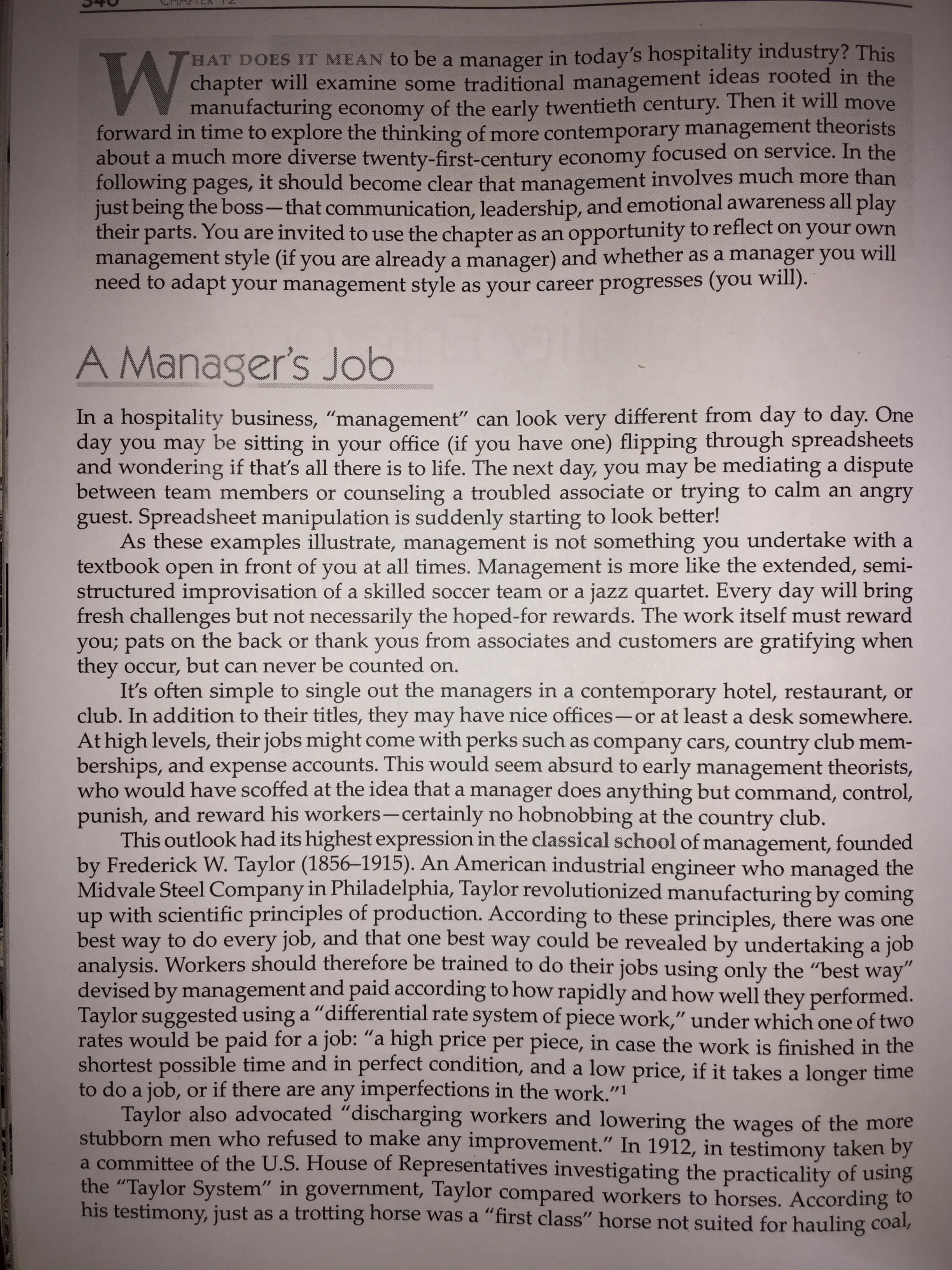Taylor, Fayol and Druckers management theories are outlined in images below each presenting a unique viewpoint on what the responsibilities of a manager are. Review
Taylor, Fayol and Drucker’s management theories are outlined in images below each presenting a unique viewpoint on what the responsibilities of a manager are. Review these theories and explain how each of Taylor, Fayol and Drucker’s theories are applicable, or not applicable, to the hospitality industry today, and provide reasoning for your opinion. (10 marks)
HAT DOES IT MEAN to be a manager in today's hospitality industry? This chapter will examine some traditional management ideas rooted in the manufacturing economy of the early twentieth century. Then it will move forward in time to explore the thinking of more contemporary management theorists about a much more diverse twenty-first-century economy focused on service. In the following pages, it should become clear that management involves much more than just being the boss-that communication, leadership, and emotional awareness all play their parts. You are invited to use the chapter as an opportunity to reflect on your own management style (if you are already a manager) and whether as a manager you need to adapt your management style as your career progresses (you will). W will A Manager's Job In a hospitality business, "management" can look very different from day to day. One day you may be sitting in your office (if you have one) flipping through spreadsheets and wondering if that's all there is to life. The next day, you may be mediating a dispute between team members or counseling a troubled associate or trying to calm an angry guest. Spreadsheet manipulation is suddenly starting to look better! As these examples illustrate, management is not something you undertake with a open in front of you at all times. Management is more like the extended, semi- structured improvisation of a skilled soccer team or a jazz quartet. Every day will bring fresh challenges but not necessarily the hoped-for rewards. The work itself must reward you; pats on the back or thank yous from associates and customers are gratifying when they occur, It's often simple to single out the managers in a contemporary hotel, restaurant, or club. In addition to their titles, they may have nice offices-or at least a desk somewhere. At high levels, their jobs might come with perks such as company cars, country club mem- berships, and expense accounts. This would seem absurd to early management theorists, who would have scoffed at the idea that a manager does anything but command, control, punish, and reward his workers-certainly no hobnobbing at the country club. This outlook had its highest expression in the classical school of management, founded by Frederick W. Taylor (18561915). An American industrial engineer who managed the Midvale Steel Company in Philadelphia, Taylor revolutionized manufacturing by coming with scientific principles of production. According to these principles, there was one dn but can never be counted on. best way to do every job, and that one best way could be revealed by undertaking a job analysis. Workers should therefore be trained to do their jobs using only the "best way" devised by management and paid according to how rapidly and how well they performed. Taylor suggested using a "differential rate system of piece work," under which one of two rates would be paid for a job: "a high price per piece, in case the work is finished in the shortest possible time and in perfect condition, and a low price, if it takes a longer time to do a job, or if there are any imperfections in the work."! Taylor also advocated "discharging workers and lowering the of the more stubborn men who refused to make any improvement." In 1912, in testimony taken by a committee of the U.S. House of Representatives investigating the practicality of using the "Taylor System" in government, Taylor compared workers to horses. According to his testimony, just as a trotting horse was a "first class" horse not suited for hauling coal, wages
Step by Step Solution
There are 3 Steps involved in it
Step: 1
Taylors theory focuses on maximizing the overall employee output in an organization He claims that h...
See step-by-step solutions with expert insights and AI powered tools for academic success
Step: 2

Step: 3

Ace Your Homework with AI
Get the answers you need in no time with our AI-driven, step-by-step assistance
Get Started




